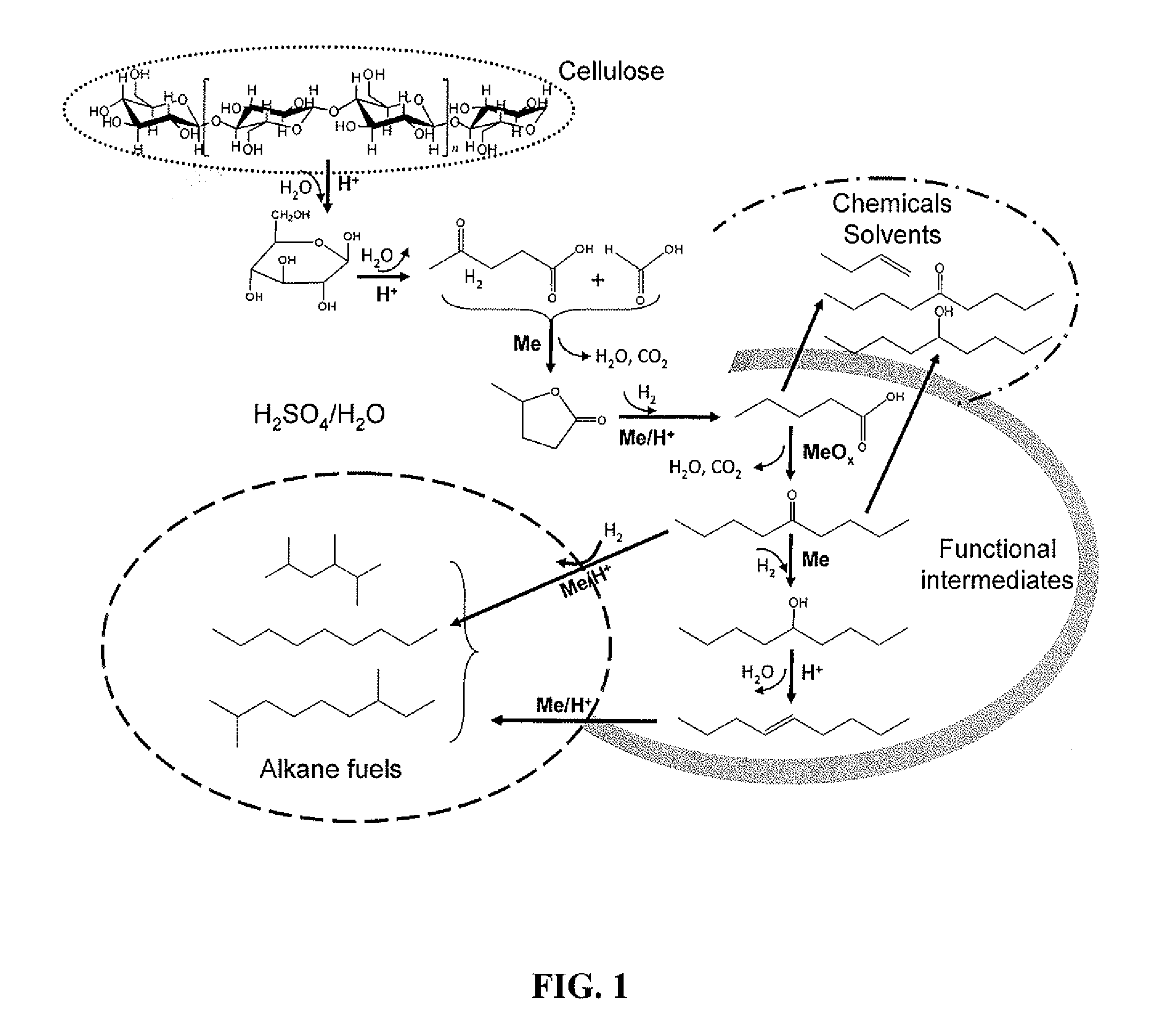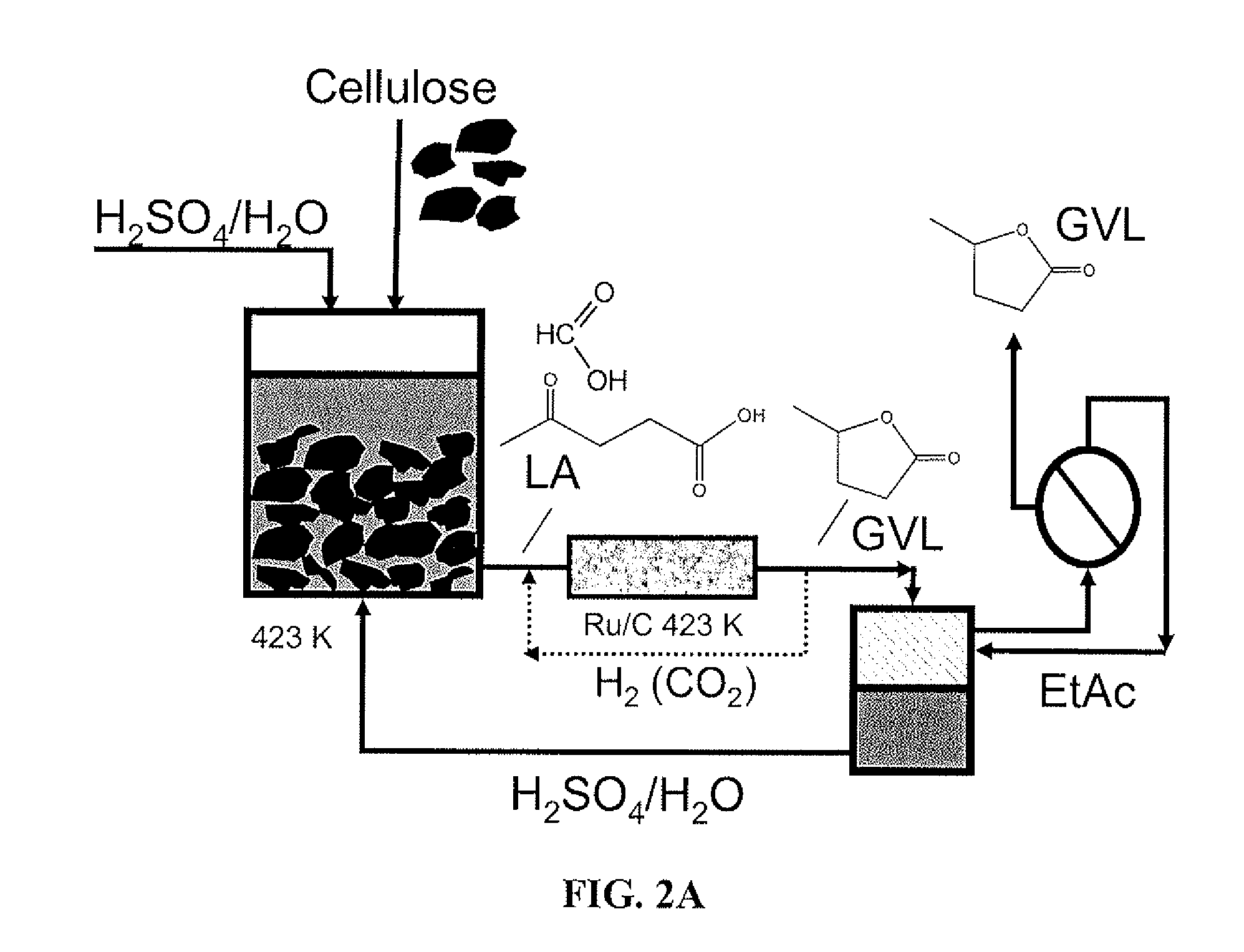Catalytic conversion of cellulose to liquid hydrocarbon fuels by progressive removal of oxygen to facilitate separation processes and achieve high selectivities
a technology of liquid hydrocarbon fuel and catalyst, which is applied in the direction of hydrocarbon oil treatment products, physical/chemical process catalysts, metal/metal-oxide/metal-hydroxide catalysts, etc., can solve the problems of expensive purification steps and alter the performance of heterogeneous catalysts used subsequently
- Summary
- Abstract
- Description
- Claims
- Application Information
AI Technical Summary
Benefits of technology
Problems solved by technology
Method used
Image
Examples
example 1
[0063]The liquid products from the cellulose deconstruction step, the conversion of levulinic acid into GVL, and the GVL extraction step were analyzed by HPLC (Waters 2695 system with a Bio-Rad Aminex HPX-87H column and a RI 410 detector) (Waters Corp., Milford, Mass., USA; Bio-Rad Laboratories, Hercules, Calif., USA). The liquid products from the conversion of GVL into pentanoic acid and the conversion of pentanoic acid into nonanone were analyzed by GC-MS (Shimadzu GC-2010 with a mass spectrometer and DB-5ms column from Alltech) and GC (Shimadzu GC-2010 with a FID detector and Rtx-5 column from Alltech) (Shimadzu Corporation, Kyoto, Japan; Alltech Associates, Inc., Deerfield, Ill., USA). Product identification was verified using a combination of GC-MS for volatile species, and retention times for GC and HPLC. The products were purchased and calibrated for GC and HPLC.
[0064]The gas phase products from the conversion of GVL into pentanoic acid were analyzed by GC usin...
example 2
Catalyst Preparation
[0065]Pd(5%) / Nb2O5 was prepared by incipient wetness impregnation of a commercial niobium oxide (HY-340 from Companhia Brasileira de Metalurgia e Mineração (CBMM), Araxa, Brazil, BET 118 m2 g−1) with an aqueous solution of Pd(NO3)2.xH2O (Sigma Aldrich, Milwaukee, Wis., USA). The catalyst was dried at 380 K overnight, followed by calcination at 538 K in flowing air (250 cm3(STP) min−1, 1 K min−1 ramp) for 2 h. The ceria-zirconia catalyst with Ce:Zr molar ratio of 1:1 was prepared according to Serrano-Ruiz, et al. (Serrano-Ruiz (2006)). A commercial Ru(5%) / C catalyst (Sigma Aldrich) was reduced at 673 K (2 K min−1 ramp then 4 h hold) with flowing H2 (100 cm3(STP) min−1) and then passivated with 2% O2 in He (100 cm3(STP) min−1) at ambient temperature for 4 h prior to use in the reaction to convert levulinic acid to GVL.
example 3
Cellulose Deconstruction to Levulinic Acid and Formic Acid
[0066]Microcrystalline cellulose (8 g, 5% moisture) with an average size of 20 μm and a 0.5 M sulfuric acid solution (92 g) were loaded into a 450 mL Parr Instruments alloy C-276 batch reactor equipped with a variable speed mechanical stir and Teflon liner (Parr Instrument Co., Moline, Ill., USA). The reactor was pressurized with inert gas (35 bar) and heated to 423 K (1.4 K min−1) with a 590 W electric heating mantle. The reactor was maintained at 423 K for 6 h while stirring. At the end of the reaction time the heating mantle was removed and the reactor was cooled with compressed air. A liquid sample (400 μL) was collected, syringe filtered (0.2 μm membrane), and analyzed by HPLC.
[0067]After a cycle of cellulose deconstruction, another batch of microcrystalline cellulose (8 g, 5% moisture) was added to the reaction mixture and the vessel was resealed. The same procedure as above was performed for multiple cycles. The solid ...
PUM
 Login to View More
Login to View More Abstract
Description
Claims
Application Information
 Login to View More
Login to View More - R&D
- Intellectual Property
- Life Sciences
- Materials
- Tech Scout
- Unparalleled Data Quality
- Higher Quality Content
- 60% Fewer Hallucinations
Browse by: Latest US Patents, China's latest patents, Technical Efficacy Thesaurus, Application Domain, Technology Topic, Popular Technical Reports.
© 2025 PatSnap. All rights reserved.Legal|Privacy policy|Modern Slavery Act Transparency Statement|Sitemap|About US| Contact US: help@patsnap.com



